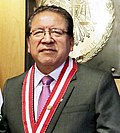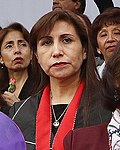Top Qs
Timeline
Chat
Perspective
Public Ministry of Peru
From Wikipedia, the free encyclopedia
Remove ads
The Public Ministry of Peru (Spanish: Ministerio Público), also known as the Prosecutor's Office of Peru (Spanish: Fiscalía del Perú), is an autonomous entity of the Government of Peru that is responsible for enforcing law in Peru. Headed by the Prosecutor of the Nation, the Public Ministry oversees investigations surrounding private citizens, public interest and legislative interrogatives.[1]
Remove ads
History
Following the creation of the Supreme Court of Peru in 1825, an entity similar to the Public Ministry served under the chief national court. The 1828 Constitution of Peru established a Supreme Court with seven justices and a prosecutor.
Jorge Basadre notes that in the National Convention of 1855, functions for a national prosecutor were more defined.[2] By 1930, it was indicated in Article 2 of the Code of Procedure in Criminal Matters that public criminal prosecution was performed by a proseuctor's office that was overseen by the Ministry of Justice.[3] In the 1979 Constitution of Peru, the Public Ministry of Peru was officially established as an independent body from the Ministry of Justice.
Remove ads
Organization
Summarize
Perspective
Attorney General of Peru
The Attorney General of Peru heads the Public Ministry. Individuals in the office must be over 45 years old and are appointed by the National Board of Justice (JNJ).
Districts
The Public Ministry has 34 districts:
- Amazonas
- Áncash
- Apurímac
- Arequipa
- Ayacucho
- Cajamarca
- Callao
- Cañete
- Cuzco
- Huancavelica
- Huánuco
- Huaura
- Ica
- Junin
- La Libertad
- Lambayeque
- Lima
- Lima Este
- Lima Norte
- Lima Noroeste
- Lima-Sur
- Loreto
- Madre de Dios
- Moquegua
- Pasco
- Piura
- Puno
- San Martín
- Santa
- Sullana
- Tacna
- Tumbes
- Ucayali
- Selva Central
Remove ads
See also
References
Wikiwand - on
Seamless Wikipedia browsing. On steroids.
Remove ads








